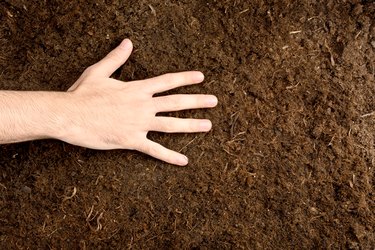
Seeing unsightly yellow fungus on the top of your soil can be alarming and off-putting. Luckily, while this can be a couple of different species, the most common are harmless. Before you take action, understand these organisms and how they interact with your soil and plants. When you see yellow fungus in soil or yellow mold on plant soil, it's almost certainly either yellow slime mold or the yellow houseplant mushroom. While these both sound – and often look – unpleasant, they are both easy to identify and range from harmless to beneficial.
Yellow Mold on Plant Soil: Fuligo septica
Video of the Day
If you've recently mulched or if you live in a cool, humid environment, you may see what looks like a yellow mold on your wood chips or plant soil. Unsightly in most of its life stages, this lifeform is often called dog vomit mold or yellow slime mold, with the scientific name Fuligo septica. However, contrary to its common names, it is not a mold or fungus at all.
Video of the Day
It has several classifications, depending on the system followed. Broadly a Eukaryote (an organism with cell nuclei), it is either a member of the Amoebozoa phylum in the cladistic (based on common ancestry) system or of the Protista kingdom in the classic five-kingdom scheme. In practice, this means it can't be classified as animal, plant or fungus. Its closest analogues are amoebas, although unlike amoebas, slime molds lack cell walls.
More on Slime Molds and Fungus
There are over 900 species of slime molds. Slime molds thrive in cool, damp environments and often arrive in your garden on wood chips and mulch. In early life stages, they are nearly undetectable as translucent membrane-encased droplets. In favorable humid conditions, multiple droplets fuse into zygotes that become plasmodia, which have multiple nuclei without membranes between them.
Yellow mold starts white or off-white, resembling its common moniker of dog vomit, and appears to travel as it gravitates towards food and nutrients, though this is simply the slime mold growing and retreating rather than displaying true locomotion. Eventually, it turns yellow, then as it dries, it releases spores that spread on the wind or through water. In these stages, individual organisms can be multiple centimeters across, and groups can be as large as feet or even yards across.
More on Yellow Fungus and Molds
While these substances may look unpleasant, they are harmless and even edible, prepared as a specialty in some areas of the world. They are also very difficult to eradicate, as most attempts, such as spraying them with a garden hose, will simply serve to spread them and provide favorable moist conditions. They can often go away on their own; most patches will disappear after one to two weeks. However, carefully extracting patches with a shovel and then turning the area to expose it to sunlight and dry it out can help.
These fungi and molds are immune to most chemical means of control, and those chemicals that do have an effect are likely to harm other organisms in and around your yard. While largely not a threat to plants, animals or humans, this species can cause some asthmatic distress or allergic rhinitis in susceptible humans.
Yellow Fungus in Soil: Leucocoprinus birnbaumii
If what you're seeing in your soil clearly looks like a yellow mushroom species, complete with stems and caps, it is likely a true fungus called Leucocoprinus Birnbaumii. This is a common mushroom in flowerpots that colonizes rich organic materials. Rather than being a pest or a sign of something wrong, these mushrooms are a harmless sign of healthy soil.
While easily identifiable in early stages by its bright yellow cap, its coloring may fade to beige or white with time. This type of mushroom is common in warm, humid climates or in indoor pots. The sudden appearance of these mushrooms in indoor potting soil especially can cause alarm and concern, but by and large, they are simply a sign of organically healthy soil. They do not harm the plants, are not known to be toxic, and do not need to be eradicated.